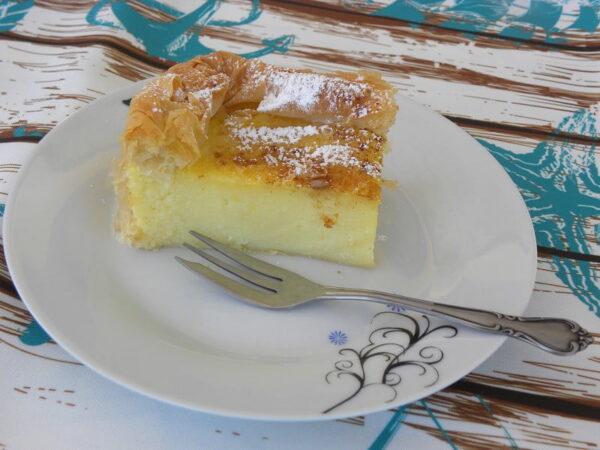Galatopita (sometimes called galopita) is one of Greece’s most cherished traditional desserts. Its name literally translates to “milk pie” or “milk cake”, and it holds a special place in the country’s culinary and cultural heritage. This sweet treat is especially popular in the Peloponnese region, where it is often prepared around Easter; however, it can also be found year-round at family gatherings, celebrations, and local festivals.
Two Regional Traditions: With or Without Filo
There are two main versions of galatopita, each reflecting the unique traditions of different regions in Greece:
-
Ioannina (Epirus) version – Made with crispy filo pastry, creating a layered dessert where sheets of delicate pastry encase a rich custard filling. Once baked, it is dusted with cinnamon and icing sugar for an aromatic finish.
-
Messinia (Peloponnese) version – Often made without filo, this version resembles a baked custard pie more closely. It is particularly associated with the weeks after Carnival (Apokries) and Holy Week, when families would use up the fresh milk and eggs they had saved during the fasting period of Lent.
Both variations celebrate the same basic elements: creamy custard, simple ingredients, and a comforting sweetness.
Ingredients and Flavours
At its heart, galatopita is a milk-based custard pie enriched with:
-
Fresh milk (traditionally sheep or goat’s milk)
-
Eggs for structure and richness
-
Semolina or flour for thickening
-
Sheep butter or sometimes cow butter, giving it depth of flavour
-
Vanilla or lemon zest for fragrance
When prepared with filo, the custard is layered between buttered sheets that crisp beautifully in the oven. Without filo, the custard is poured directly into a baking dish and baked until golden. Either way, it is typically finished with a dusting of powdered sugar and cinnamon, adding both sweetness and warmth.
To see the recipe, visit Taste Local Greece, our culinary partner
Cultural Significance
Galatopita is more than just a dessert—it is part of Greece’s seasonal rhythm and celebratory table. Traditionally, in Messinia, it was prepared after Easter, when milk and eggs were plentiful again after the fasting period. It also appears after Carnival, before the restrictions of Lent begin.
This dessert exemplifies the Greek approach to cooking: using humble, everyday ingredients—such as milk, eggs, butter, and sugar—to create something festive, indulgent, and memorable.
A Beloved Greek Sweet
Whether enjoyed warm or at room temperature, galatopita is creamy, comforting, and deeply satisfying. Its smooth texture and gentle sweetness make it a favourite for both children and adults. And, as with many Greek recipes, every household may have its own twist—slightly different proportions of milk and semolina, more lemon zest, or a heavier dusting of cinnamon.
If you have ever tasted a well-made galatopita, its richness and unique texture are unforgettable. It embodies the warmth of Greek hospitality and the tradition of gathering around a shared table.
✨ Galatopita remains a timeless symbol of Greek culinary heritage—a simple, rustic, yet luxurious dessert that bridges generations, regions, and celebrations.




